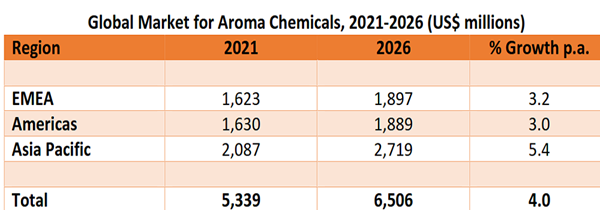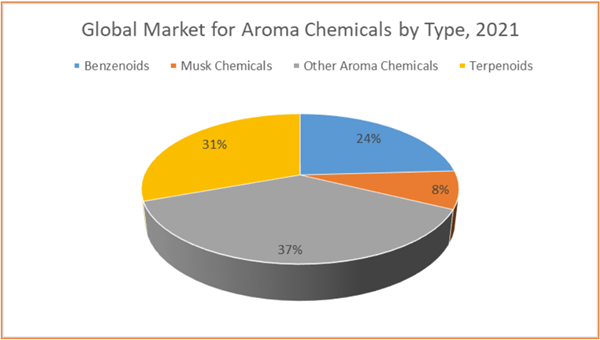The fully updated market report Global Overview of the Aroma Chemicals Market, 3rd Edition brings together the most recent information available on the Global Markets for Aroma Chemicals, complementing the research on the Global Flavours and Fragrances Markets. All the data in this report plus additional historical trends and forecasts are available in the unique online database. Various packages are available.
The reports cover the following product types and end-use sectors:
Aroma Chemicals (AC):
Product types: Benzenoids, Terpenoids, Musk Chemicals, Others
End-use Applications: Cosmetics & Toiletries, Fine Fragrances, Soap & Detergents, Food, Beverages, and Others
Geographic Scope
The following regions are included in this volume and are broken down further into the following countries: Europe, Middle East & Africa (EMEA)
Western Europe
Austria, Belgium, Denmark, Finland, France, Germany, Greece (CI only), Ireland, Italy, Netherlands, Norway, Portugal, Spain, Sweden, Switzerland, UK.
Central & Eastern Europe
Belarus (CI only), Czech Republic, Hungary, Poland, Romania (CI only), Russia, Slovakia (CI only), Turkey, Ukraine (CI only)
Middle East & Africa
Egypt, Iran, Israel, Morocco (CI only), Nigeria (AC only), Saudi Arabia, South Africa, UAE.
Americas
Central & North America
USA, Canada, Mexico.
South America
Argentina, Brazil, Chile, Colombia Peru (CI only), Venezuela (AC only).
Asia Pacific
Australia, Bangladesh (CI only), China, India, New Zealand (CI only), Indonesia, Japan, Malaysia, Pakistan, Philippines, Singapore, South Korea, Taiwan, Thailand, Vietnam.
COVERAGE
Aspects of the markets covered in these studies:
- Consumption of aroma chemicals by global region and country by value (US$), 2021 and 2026
- Market breakdown by product type (by country) and end-use application (by region) for 2021 and 2026
- Principal trends and factors affecting the markets
- Overview of suppliers and global market shares
- Top-level analysis of market volumes for 2021
The information contained within these reports is based upon an extensive programme of interviews throughout the industry. The reports contain market value data by product type and end-use application, with 2021 as the base year and market forecasts provided to 2026.
Table of Contents
1 Introduction
Samples

LOADING...
Executive Summary
Aroma chemicals are single, chemically defined/identifiable substances that act on the senses of smell and taste. They are the starting point, the ‘backbone’, for flavour and fragrance compounds.
The global market for aroma chemicals is estimated at US$5,339 million for 2021 and is forecast to reach US$6,506 million by 2026. Terpenoids represent the largest single product category, with a share of 31%, followed by benzenoids with 24%. Typically, the market is propelled by continuously increasing demand for fragrances and their downstream applications. Growth in 2021 was 3.9%, after just 1.3% growth in 2020.
The market for aroma chemicals is concentrated in the EU, US and China. Demand is lower in developing markets, as there is little perfumery (blending) activity, and these countries are much more likely to purchase ready-made compounds. Demand for aroma chemicals is high in Asia because there is a lot of use of synthetic flavour and fragrance compounds.
For 2022 as a whole, the analyst is forecasting growth of 4.1%. However, within the growth for 2022, there is a mix of inflationary pressure causing higher prices, coupled with a volume decline as the cost-of-living crisis worsens. High inflation is likely to continue into 2023 and may dampen demand as consumers are once again forced to change their spending habits and prioritise everyday products over non-essentials. This will have a knock-on effect on the fine fragrance segment once again, as was seen during the pandemic.
Several trends are evident in the aroma chemicals market globally. The first is regulatory: producers of aroma chemicals are driven by standards and regulations and must constantly check for product impurities. Each year there are new regulatory bans on certain molecules. Secondly, the demand for natural aroma chemicals has never been higher, responding to consumer preferences for greener, traceable and sustainable products. The third is the emergence of biotech-based molecules, which are produced by methods akin to fermentation. Other key market drivers include raw material availability and ecotoxicology concerns.
Among the leading global suppliers of aroma chemicals are IFF, Symrise, Firmenich, BASF, Givaudan, NHU and DSM. Competition from Chinese and Indian players is intensifying. The analyst’s top-level analysis suggests that the 15 largest producers of aroma chemicals hold a share of approximately 82% of the global market, in terms of supply. The remainder of the market is fragmented and occupied by small and midsized players often operating at local or regional level or in niche segments.
Companies Mentioned (Partial List)
A selection of companies mentioned in this report includes, but is not limited to:
- BASF
- DSM
- Firmenich
- Givaudan
- IFF
- Mane
- NHU
- Solvay
- Symrise
- Yingyang Aroma
Methodology
Information provided in these reports are based on existing in-house data and an extensive programme of interviews with leading product manufacturers, trade associations, distributors and raw materials producers involved with the specific market researched. These interviews are conducted within the 3-6 months leading up to the publication of the study, with the duration of the research programme and the number of interviews completed depending on the scope of the study. The analyst publishes both regional and global reports, and in most cases, the interviews are conducted in the native language of the individual respondents.
In addition, published data and statistics are also reviewed in order to produce as accurate figures as possible for size of markets studied. Market forecasts are based upon industry and economic forecasts as well as upon other relevant commercial and technical issues likely to affect individual market sectors and products, as well as the interviews conducted for the study.

LOADING...










